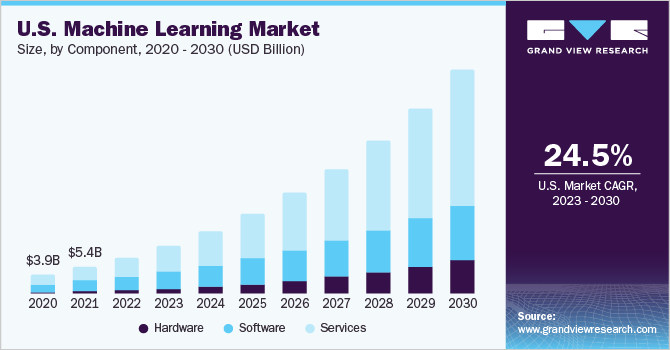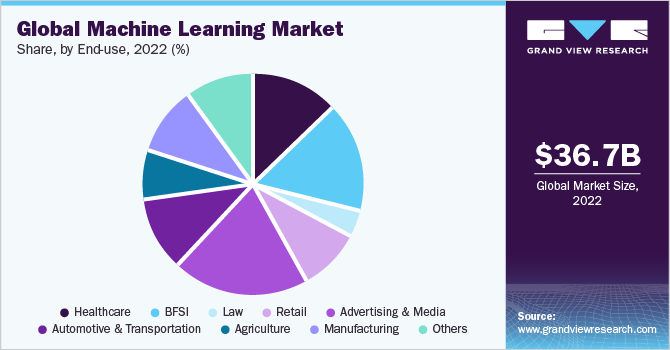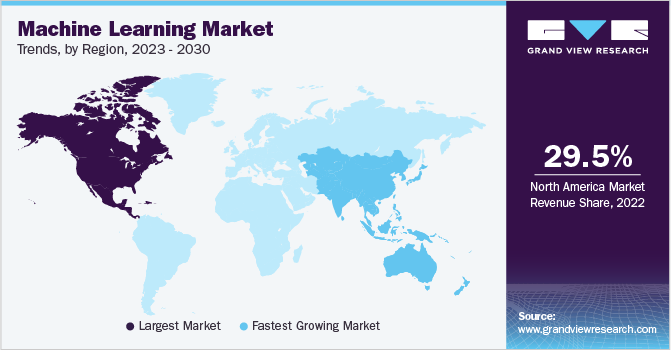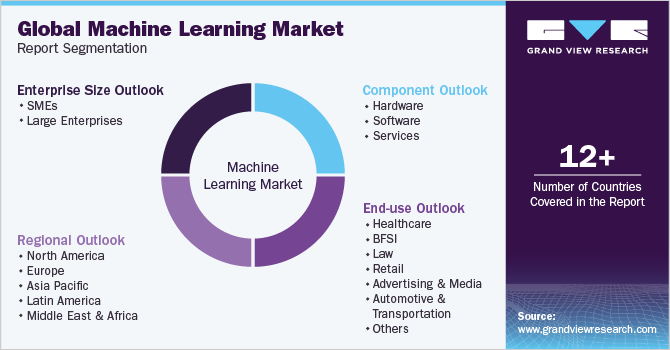- Home
- »
- Next Generation Technologies
- »
-
Machine Learning Market Size, Share & Growth Report, 2030GVR Report cover
![Machine Learning Market Size, Share & Trends Report]()
Machine Learning Market Size, Share & Trends Analysis Report By Component (Hardware, Software, Services), By Enterprise Size, By End-use (Advertising & Media, Healthcare, Retail), By Region, And Segment Forecasts, 2023 - 2030
- Report ID: GVR-4-68038-095-8
- Number of Report Pages: 100
- Format: PDF, Horizon Databook
- Historical Range: 2017 - 2021
- Forecast Period: 2023 - 2030
- Industry: Technology
Report Overview
The global machine learning market size was valued at USD 36.73 billion in 2022 and is expected to grow at a compound annual growth rate (CAGR) of 34.8% from 2023 to 2030. Artificial Intelligence (AI) is an emerging technology transforming how businesses and people operate. Through the development of several digital services and products, as well as supply chain optimization, these technologies have revolutionized the consumer experience. While some startups concentrate on solutions for specialized domains, numerous technology firms invest in this area to create AI platforms. Machine Learning (ML), one of the AI approaches, is getting a lot of momentum in the industry due to its quick progress.

Automation is a key trend in machine learning, intending to reduce manual labor to construct and deploy models. Platforms for automated machine learning (AutoML) are becoming increasingly common, allowing non-experts to take advantage of machine learning capabilities and quicken model building. Moreover, Deep learning, a machine learning that uses multiple-layer neural networks, is also improving. This tendency, the availability of enormous datasets, and the creation of more effective algorithms are all driven by advancements in processing capacity. Deep learning provides innovations in speech recognition, natural language processing, and computer vision.
Technology has paved the way across various applications. This technology is used in advertising to forecast consumer behavior and enhance advertising efforts. Different models are used in AI-driven marketing to automate, augment, and enhance the data into actions. Machine learning is used in banking and finance to complete loan approval and asset management tasks. This technology is used in other applications, such as document management, security, and publishing, propelling the industry's growth.
Machine learning is transforming healthcare by aiding in medical diagnostics. For instance, Google's DeepMind division created an algorithm that can recognize retinal pictures of eye conditions like diabetic retinopathy. Early detection, prompt treatment, and a reduction in the workload for medical staff are all made possible by this technology. In addition, personalized medicine, disease outbreak prediction, and medication development also involve machine learning.
Component Insights
The service segment dominated the market in 2022 with a revenue share of 51.6%. Based on component, the market is divided into hardware, software, and service. Over the projection period, the hardware segment is anticipated to expand at the greatest CAGR. It can be related to the rising use of machine learning-optimized hardware. Creating specialized silicon processors with AI and ML capabilities is fueling hardware adoption. It is projected that the industry will continue to grow due to firms like SambaNova Systems developing processing devices with greater power.
The software segment is likely to account for a modest market share. Due to improved cloud infrastructure and hosting characteristics, the usage of cloud-based applications is projected to increase. Adoption is accelerated by cloud-based software since it enables users to switch from machine learning to deep learning. In recent years, there has been an increase in demand for machine learning services. Customers may manage their ML tools and cope with a variety of dependency stacks with the use of managed services.
Enterprise Size Insights
The large enterprises segment dominated the market in 2022 with a revenue share of 65.9%. Based on enterprise size, the machine learning market is categorized into Small and Medium Enterprises (SMEs) and large enterprises.Large businesses are utilizing cloud-based machine learning platforms and services more and more. Cloud platforms' scalable and economic infrastructure makes machine learning model training and deployment possible. Large enterprises can use machine learning without making significant infrastructure investments thanks to services like Amazon Web Services (AWS), Google Cloud AI Platform, and Microsoft Azure Machine Learning which offer pre-built models, distributed training capabilities, and infrastructure management.
The adoption of machine learning is rapidly increasing among small and medium-sized enterprises. Due to their sometimes-constrained resources, SMEs may require additional skills to analyze significant data. Machine learning platforms and technologies may automate data analysis procedures, enabling SMEs to gain insightful knowledge from their data without putting in much human work. SMEs may better understand consumer behavior, enhance inventory management, optimize marketing efforts, and make data-driven choices using automated data analysis.
End-use Insights
The advertising & media segment dominated the market in 2022 with a revenue share of 20.0%. Hyper-personalization is one of the key trends in which machine learning algorithms analyze enormous volumes of user data to produce highly personalized and pertinent adverts that boost engagement and conversion rates. Another trend is cross-channel optimization, in which machine learning algorithms plan budgets and modify bidding schemes to optimize advertising campaigns across several channels. Additionally, a growing emphasis is on ad fraud detection using machine learning. Advertisers are leveraging machine learning algorithms to identify and prevent fraudulent activities such as click and impression fraud, ensuring that ad campaigns are effective, and budgets are protected.

The law segment is expected to register the highest CAGR over the forecast period. In the law segment, machine learning is transforming how legal professionals handle tasks, process information, and make decisions. Several key trends are shaping the use of machine learning in the legal industry. Predictive analytics is gaining prominence, where machine learning algorithms analyze vast amounts of legal data to predict case outcomes, assess risks, and support legal strategies. This trend enables lawyers to make data-driven decisions and improve efficiency in case management which is driving the growth of the segment.
Regional Insights
The North America segment dominated the market in 2022 with a revenue share of 29.5%. With the increasing impact of machine learning on society, there is a growing emphasis on ethical AI and responsible AI practices in North America. Organizations prioritize fairness, transparency, and accountability in machine learning models and algorithms. Efforts are being made to mitigate biases, ensure privacy protection, and address ethical considerations related to AI applications. Regulatory frameworks, guidelines, and industry standards are being developed to govern the region's responsible use of machine learning.

Machine learning and AI technologies are being quickly adopted in Asia Pacific nations, including China, India, and South Korea. Emerging economies use AI to boost productivity, promote economic growth, and tackle societal issues. The region's machine-learning industry is expanding due to government efforts, investments in R&D, and robust technological ecosystems. For instance, In January 2023, Baidu Inc. intended to introduce a chatbot service using artificial intelligence similar to OpenAl's ChatGPT. In March, the biggest search engine in China plans to release a ChatGPT-like app, first incorporating it within its core search functions.
Key Companies & Market Share Insights
The industry is highly competitive due to the presence of so many well-known companies. Players have used partnerships, joint ventures, agreements, and expansions. They are producing new products with faster speeds and improved features to broaden their portfolio and maintain a dominant market position. For instance, in January 2022, Acquia, Inc. deployed advanced retail machine learning models to raise client lifetime value for their customer data platform. With this launch, the organization wanted to provide merchants with a comprehensive understanding of their business. Acquia, Inc. helps businesses identify the levers that affect their marketing and sales initiatives.
In another instance,in May 2023, Infineon Technologies AG acquired Imagimob AB, a prominent platform supplier for edge-device Machine Learning solutions in Stockholm. With this acquisition, Infineon Technologies AG strengthened its position as a superior Machine Learning (ML) solution provider and greatly expanded upon its AI products. Imagimob AB offers a complete machine-learning toolchain that is extremely adaptable and simple to use, with a strong emphasis on generating production-grade ML models. Some prominent players in the global machine learning market include:
-
Amazon Web Services, Inc.
-
Baidu Inc.
-
Google Inc.
-
H2o.AI
-
Hewlett Packard Enterprise Development LP
-
Intel Corporation
-
International Business Machines Corporation
-
Microsoft Corporation
-
SAS Institute Inc.
-
SAP SE
Machine Learning Market Report Scope
Report Attribute
Details
Market size value in 2023
USD 52.02 billion
Revenue forecast in 2030
USD 419.94 billion
Growth rate
CAGR of 34.8% from 2023 to 2030
Base year for estimation
2022
Historical data
2017 - 2021
Forecast period
2023 - 2030
Report updated
July 2023
Quantitative units
Revenue in USD billion and CAGR from 2023 to 2030
Report coverage
Revenue forecast, company ranking, competitive landscape, growth factors, and trends
Segments covered
Component, enterprise size, end-use, region
Regional scope
North America; Europe; Asia Pacific; Latin America; MEA
Country scope
U.S.; Canada; UK; Germany; France; China; Japan; India; South Korea; Australia; Brazil; Mexico; Kingdom of Saudi Arabia (KSA); UAE; South Africa
Key companies profiled
Amazon Web Services, Inc.; Baidu Inc.; Google Inc.; H2o.AI; Hewlett Packard Enterprise Development LP; Intel Corporation; International Business Machines Corporation; Microsoft Corporation; SAS Institute Inc.; SAP SE
Customization scope
Free report customization (equivalent up to 8 analysts working days) with purchase. Addition or alteration to country, regional, and segment scope.
Pricing and purchase options
Avail customized purchase options to meet your exact research needs. Explore purchase options
Global Machine Learning Market Report Segmentation
This report forecasts revenue growth at global, regional, and country levels and provides an analysis of the latest industry trends in each of the sub-segments from 2017 to 2030. For this study, Grand View Research has segmented the global machine learning market report based on component, enterprise size, end-use, and region:

-
Component Outlook (Revenue, USD Billion, 2017 - 2030)
-
Hardware
-
Software
-
Services
-
-
Enterprise Size Outlook (Revenue, USD Billion, 2017 - 2030)
-
SMEs
-
Large Enterprises
-
-
End-use Outlook (Revenue, USD Billion, 2017 - 2030)
-
Healthcare
-
BFSI
-
Law
-
Retail
-
Advertising & Media
-
Automotive & Transportation
-
Agriculture
-
Manufacturing
-
Others
-
-
Regional Outlook (Revenue, USD Billion, 2017 - 2030)
-
North America
-
U.S.
-
Canada
-
-
Europe
-
Germany
-
UK
-
France
-
-
Asia Pacific
-
China
-
Japan
-
India
-
South Korea
-
Australia
-
-
Latin America
-
Brazil
-
Mexico
-
-
Middle East and Africa
-
Kingdom of Saudi Arabia (KSA)
-
UAE
-
South Africa
-
-
Frequently Asked Questions About This Report
b. The global machine learning market size was estimated at USD 36.73 billion in 2022 and is expected to reach USD 52.02 billion in 2023.
b. The global machine learning market is expected to grow at a compound annual growth rate of 34.8% from 2023 to 2030 to reach USD 419.94 billion by 2030.
b. North America dominated the machine learning market with a share of 29.5% in 2022. This is attributable to numerous banking organizations in the region investing in ML-based firms.
b. Some key players operating in the machine learning market include Amazon Web Services, Inc.; Baidu Inc.; Google Inc.; H2O.ai; Intel Corporation; International Business Machines Corporation; Hewlett Packard Enterprise Development LP; and Microsoft Corporation.
b. Key factors that are driving the market growth include increasing applications of the machine learning algorithms and rising adoption of advanced technologies.
Share this report with your colleague or friend.
![gvr icn]()
NEED A CUSTOM REPORT?
We can customize every report - free of charge - including purchasing stand-alone sections or country-level reports, as well as offer affordable discounts for start-ups & universities. Contact us now
![Certified Icon]()
We are GDPR and CCPA compliant! Your transaction & personal information is safe and secure. For more details, please read our privacy policy.
We are committed towards customer satisfaction, and quality service.
"The quality of research they have done for us has been excellent."





